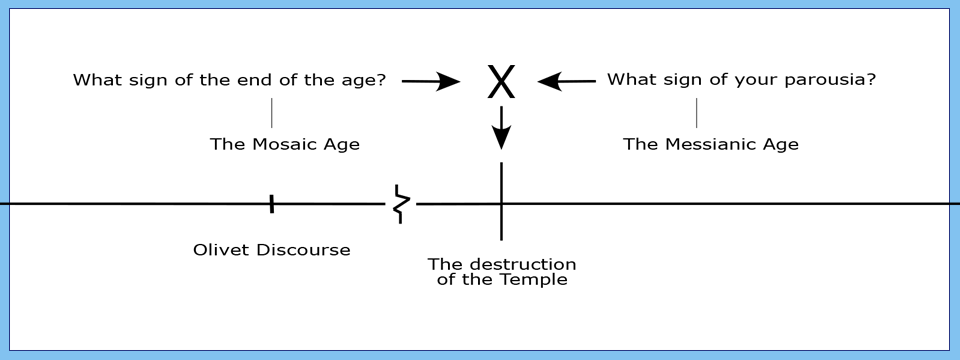
Our previous post asserted the Olivet Discourse has a single topic—Jesus’ prophecy of the Temple’s destruction. We showed how the disciples correctly associated that event with the end of the Mosaic age. Here we wish to show how the other part of the disciples’ sign question—“what shall be the sign of thy coming (Greek, parousia)?” (Matthew 24:3)—supports our one-subject thesis.
At first glance, we might conclude the disciples were confused. Today, we associate the “coming” of the Lord with the end of history, or at least with the end of the church age. To us, their question seems out of place. Did they associate the destruction of the Temple (Matthew 24:1–2) with events in their distant future? Or, did they imagine the end of time was in their near future? Either way, modern readers have difficulty following their logic.
We believe the disciples were not confused at this point. As we saw, they knew the destruction of the Temple would end the Mosaic age. They also understood the new Messianic age—which Christ had already started—would remain. (See Matthew 10:7; 16:19; 18:1 and many others.) They may have misunderstood the nature of the new age, but they were not in doubt about its existence. They associated the Temple’s fall not only with the end of the Mosaic age but also with the events that initiated the Messianic age.
The confusion is ours. And it concerns our misunderstanding of the Greek word parousia the disciples used in their question. Most modern Bible versions translate this word as “coming.” Because of this, we conceive of the parousia of Christ as a point-in-time event. Jesus “went away” after his resurrection and he will “come again” at the parousia.
This point-in-time conception undercuts the fundamental meaning of parousia. This word signifies “presence,” not “coming.” The opposite of parousia is “absence.” If parousia meant “coming,” its antonym would be “going.” This is not the case, as the apostle Paul makes clear: “Wherefore, my beloved, as ye have always obeyed, not as in my presence (parousia) only, but now much more in my absence, work out your own salvation with fear and trembling” (Philippians 2:12; emphasis added). Again, parousia means “presence,” not “coming.”
We should let the word’s definition dictate our understanding of the disciples’ question. Parousia “denotes a state, not an action.”1 The disciples understood the destruction of the Temple would usher in a new “state”—the kingdom of God.
Hermann Cremer, a Greek authority, reinforces the appropriateness of the disciples’ use of parousia: “Ewald acutely says, ‘The [Parousia of Christ] perfectly corresponds with the [Shekinah] of God in the O. T.,—the permanent dwelling of the King, where His people ever behold Him, and are ever shielded by Him.’”2 The Shekinah was in the physical Temple at Jerusalem. Its counterpart—the parousia of Christ—would live in the new Temple (i.e., the church) during the new age (Ephesians 2:21; 1 Peter 2:5).
The disciples’ use of parousia (presence) to describe the Messianic age is, therefore, fitting. The prophets had portrayed the presence of God with his people as a leading characteristic of the new age. Paul’s letters to the Corinthians—written after the Olivet Discourse, but before the fall of the Temple—show this perspective: “God hath said, I will dwell in them, and walk in them; and I will be their God, and they shall be my people” (2 Corinthians 6:16). In a word, God would be present with his people. Parousia accurately and fully reflects this new residence of God with his people.
The words “parousia of Christ” describe the Messianic age. They depict the new-covenant state inaugurated by the earthly ministry of Christ; his death, burial, and resurrection; the giving of the Holy Spirit; and the ministry of the apostles. The destruction of the Temple completed the transition to the new age during which Christ’s presence dwells in the new Temple not made with hands.
So, the disciples’ request for a sign related to Christ’s parousia was not the result of their confusion. On the contrary, it shows their understanding of what the destruction of the Temple would signify. They did not change the subject of the Olivet Discourse. Instead, they followed Jesus’ lead. They knew the event of which he spoke would usher in the long-expected new age—the parousia of Christ.
We can paraphrase the disciples’ questions as follows: “what shall be the sign of thy (new-age) presence, and of the end of the (old, Mosaic) age?” (Matthew 24:3).
The following diagram depicts the two parts of the disciples’ sign question and their relationship to the destruction of the Temple:

Footnotes
- W. E. Vine, Collected Writings of W. E. Vine (Nashville, TN: T. Nelson, 1996), 5:149.
- Hermann Cremer, Biblico-Theological Lexicon of New Testament Greek, trans. William Urwick (New York: Charles Scribner’s Sons, 1895), 238. Referenced by Vine, ibid; his translations of the Greek and Hebrew shown in brackets.

2 comments
Os humanos desconfiados vão continuar em guerra. A felicidade será ludibriada pela alegria. A vida no planeta vai continuar pobre, oprimida e doente. A chave da felicidade continuará sendo a santidade. A esperança, a exclusivo critério dos Céus, é uma luz de total não beligerância entre os humanos. O desfecho final quando Deus será tudo em todos em todas as coisas está em marcha nestes últimos tempos. E este termo de tudo não se dará sem que haja uma última investida de todas as forças e potências do mal. E até lá a carne vai continuar revolta com o espírito. Nesta rebeldia o secularismo irromperá cada vez mais imponente transvestido de poder e gozo e consequências trágicas. Mas naquele tremendo e glorioso dia não perguntaremos mais nada!…:)
Pedro,
Thank you for this comment. I do not know Portuguese, so I will rely on Google Translate. Here is the English it provided with some of my assumptions:
I agree with much of what (I think) you said. Evil will continue to exist in the Messianic Age. God will not remove it from his creation until the day of the resurrection.
My disagreements involve the concept of “these latter times.” I believe Scripture almost always uses this term to refer to the last part of the Mosaic Age. Also, the idea that evil will grow “more and more” presents a problem. The Bible teaches that the kingdom of God will grow “more and more” until the knowledge of the Lord covers the earth as the waters cover the sea (Isa 11:9; Hab 2:14). Several of my blog posts establish these points, so I will not repeat the reasons here.
Let us continue praying that the kingdom will come such that God’s will be done on earth as it is in heaven (Matt 6:10).
Please let me know if I have misunderstood your meaning!
Yours in Christ,
Mike